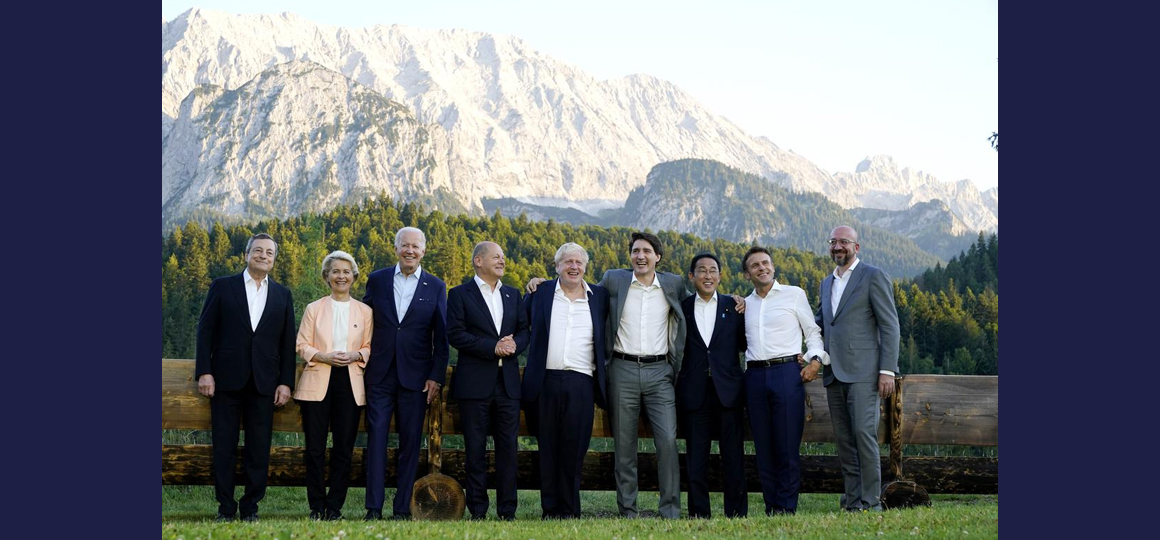What is the proposed agritech and climate sustainability fund? Will India get adequate funds for infrastructure development?
The story so far: On June 26, the G-7 grouping of the world’s “most industrialised nations” — Canada, France, Germany, Italy, Japan, the U.K. and the U.S. along with the European Union — launched a U.S.-led $600 billion Partnership for Global Infrastructure and Investment (PGII) at their summit in Germany’s Schloss Elmau, where India was among five special invitees. The initiative was billed as a “values-driven, high-impact, and transparent infrastructure partnership to meet the enormous infrastructure needs of low- and middle-income countries and support the U.S. and its allies’ economic and national security interests.” Officials also made it clear that the PGII would offer a counter to China’s Belt and Road Initiative (BRI) for projects worldwide that was formally launched five years ago.
What was India’s response?
A day after U.S. President Joseph Biden made his PGII announcement, Foreign Secretary Vinay Kwatra said. “I think the [PGII]…is a separate G-7 initiative and to my recollection, unless there is some other input, I think it is not a G-7 outreach initiative,” adding, “We will have to see the details of that for us to be able to speak specifically on its elements.”
Why is the response significant?
To begin with, Mr. Kwatra’s response indicates that India was not privy to PGII consultations, nor was the infrastructure plan part of the documents that were signed by India, Indonesia, South Africa, Senegal and Argentina, who were part of the “G-7 outreach” invitees to the summit. (The EU has participated in the G-7 since 1981 as a “nonenumerated” member).
The distinction is interesting because just a month ago, at the Quad Summit in Tokyo, Prime Minister Narendra Modi had attended the launch of the U.S. led “Indo-Pacific Economic Initiative” (IPEF) with similarly sudden plans, and India had joined as an “initial” or founding partner country.
It also came as a surprise that India hadn’t endorsed the PGII plan given that the U.S. billed it as a rival to China’s BRI, with much more sensitivity to sustainable debt burdens and environmental concerns. India has actively opposed the BRI because it had ignored these reasons and for its “violation of territorial integrity”.
Is there any specific role for India?
According to U.S. officials, the PGII will have four key priorities on infrastructure: climate and energy security, digital connectivity, health and health security, and gender equality and equity, all of which are priority areas for New Delhi as well. The PGII “factsheet” released by the White House also includes a specific plan for investment in an Agritech and Climate sustainability fund that would “invest in companies that increase food security and promote both climate resilience and climate adaptation in India, as well as improve the profitability and agricultural productivity of smallholder farms.” According to the documents, the India fund would target $65 million by September 2022, and a target capitalisation of $130 million in 2023. The U.S. government’s International Development Finance Corporation (DFC) would mobilise $30 million in private capital for the fund.
What could be some of the reasons for India’s reticence on PGII?
The Ministry of External Affairs has not yet expanded on its initial response to the PGII, and it is quite possible, that once it has studied and verified its strategy, it will endorse it. One of the reasons for some scepticism in New Delhi is that the PGII is one of a number of U.S.-led economic initiatives announced globally and in the Indo-Pacific, without much clarity on whether they would overlap, or run concurrently with each other. At the Quad Summit, Mr. Biden committed to a $50 billion infrastructure fund over five years. The PGII announcement for $600 billion over five years also comes a year after the U.S. led a G-7 initiative to counter China’s “strategic competition” and to narrow the roughly $40 trillion “infrastructure gap” in the developing world.
Last year, the Biden administration also revived a Trump administration project for the “Blue Dot Network Initiative” to certify infrastructure projects, but had stopped short of funding them. Another reason for the Indian reaction, say analysts, could be to show consistency, given India’s earlier reaction to the BRI, when it was first announced by Xi Jinping in 2013, years before the formal launch in 2017. “When China first unveiled the BRI, India’s initial response was also that this was a plan with geopolitical consequences that India had not been consulted on. India said it would have to study before responding. It is possible that the Modi government’s cautiousness on PGII is about striking a similar balance,” said Sanjaya Baru, author, policy analyst and Distinguished Fellow at the United Services Institution of India (USI).
Explained | How will G-7’s infrastructure plan impact India?
What is the proposed agritech and climate sustainability fund? Will India get adequate funds for infrastructure development?
The story so far: On June 26, the G-7 grouping of the world’s “most industrialised nations” — Canada, France, Germany, Italy, Japan, the U.K. and the U.S. along with the European Union — launched a U.S.-led $600 billion Partnership for Global Infrastructure and Investment (PGII) at their summit in Germany’s Schloss Elmau, where India was among five special invitees. The initiative was billed as a “values-driven, high-impact, and transparent infrastructure partnership to meet the enormous infrastructure needs of low- and middle-income countries and support the U.S. and its allies’ economic and national security interests.” Officials also made it clear that the PGII would offer a counter to China’s Belt and Road Initiative (BRI) for projects worldwide that was formally launched five years ago.
What was India’s response?
A day after U.S. President Joseph Biden made his PGII announcement, Foreign Secretary Vinay Kwatra said. “I think the [PGII]…is a separate G-7 initiative and to my recollection, unless there is some other input, I think it is not a G-7 outreach initiative,” adding, “We will have to see the details of that for us to be able to speak specifically on its elements.”
Why is the response significant?
To begin with, Mr. Kwatra’s response indicates that India was not privy to PGII consultations, nor was the infrastructure plan part of the documents that were signed by India, Indonesia, South Africa, Senegal and Argentina, who were part of the “G-7 outreach” invitees to the summit. (The EU has participated in the G-7 since 1981 as a “nonenumerated” member).
The distinction is interesting because just a month ago, at the Quad Summit in Tokyo, Prime Minister Narendra Modi had attended the launch of the U.S. led “Indo-Pacific Economic Initiative” (IPEF) with similarly sudden plans, and India had joined as an “initial” or founding partner country.
It also came as a surprise that India hadn’t endorsed the PGII plan given that the U.S. billed it as a rival to China’s BRI, with much more sensitivity to sustainable debt burdens and environmental concerns. India has actively opposed the BRI because it had ignored these reasons and for its “violation of territorial integrity”.
Is there any specific role for India?
According to U.S. officials, the PGII will have four key priorities on infrastructure: climate and energy security, digital connectivity, health and health security, and gender equality and equity, all of which are priority areas for New Delhi as well. The PGII “factsheet” released by the White House also includes a specific plan for investment in an Agritech and Climate sustainability fund that would “invest in companies that increase food security and promote both climate resilience and climate adaptation in India, as well as improve the profitability and agricultural productivity of smallholder farms.” According to the documents, the India fund would target $65 million by September 2022, and a target capitalisation of $130 million in 2023. The U.S. government’s International Development Finance Corporation (DFC) would mobilise $30 million in private capital for the fund.
What could be some of the reasons for India’s reticence on PGII?
The Ministry of External Affairs has not yet expanded on its initial response to the PGII, and it is quite possible, that once it has studied and verified its strategy, it will endorse it. One of the reasons for some scepticism in New Delhi is that the PGII is one of a number of U.S.-led economic initiatives announced globally and in the Indo-Pacific, without much clarity on whether they would overlap, or run concurrently with each other. At the Quad Summit, Mr. Biden committed to a $50 billion infrastructure fund over five years. The PGII announcement for $600 billion over five years also comes a year after the U.S. led a G-7 initiative to counter China’s “strategic competition” and to narrow the roughly $40 trillion “infrastructure gap” in the developing world.
Last year, the Biden administration also revived a Trump administration project for the “Blue Dot Network Initiative” to certify infrastructure projects, but had stopped short of funding them. Another reason for the Indian reaction, say analysts, could be to show consistency, given India’s earlier reaction to the BRI, when it was first announced by Xi Jinping in 2013, years before the formal launch in 2017. “When China first unveiled the BRI, India’s initial response was also that this was a plan with geopolitical consequences that India had not been consulted on. India said it would have to study before responding. It is possible that the Modi government’s cautiousness on PGII is about striking a similar balance,” said Sanjaya Baru, author, policy analyst and Distinguished Fellow at the United Services Institution of India (USI).






NO COMMENT